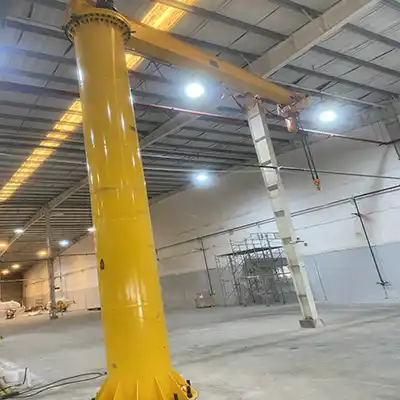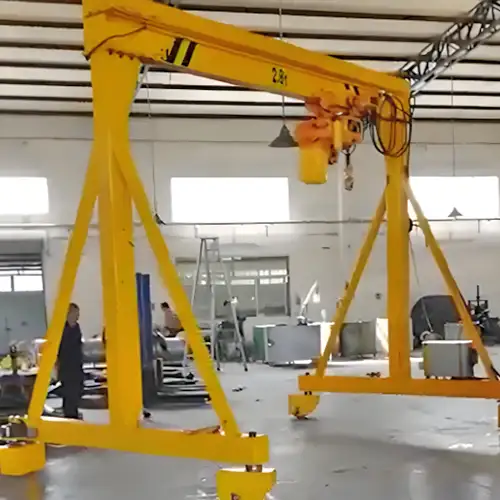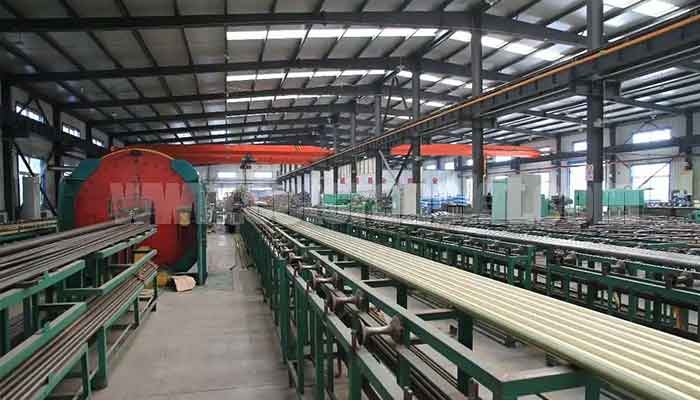
Overhead Crane for Rubber Industry | Cost-effective Bridge Crane
Overhead cranes with single girder & double girder design for rubber processing factory. Cost-effective bridge crane for sale 5 ton, 10 ton, 20 ton +.
Overview of rubber industry
The rubber industry refers to the sector involved in the production, processing, and commercialization of rubber and rubber based products. Rubber is a versatile, elastic material that is obtained primarily from the latex of certain plants, such as the rubber tree (Hevea brasiliensis). This natural rubber is widely used in various industries due to its unique properties, such as elasticity, flexibility, and water resistance.
The rubber industry can be broadly categorized into two main sectors:
- Natural Rubber Industry: This sector involves the cultivation of rubber trees in plantations, the extraction of latex from the trees, and the processing of latex into raw rubber. The primary countries known for natural rubber production are Thailand, Indonesia, Malaysia, Vietnam, and India.
- Synthetic Rubber Industry: Synthetic rubber is derived from petroleumbased materials and is produced through chemical processes. It was developed as a substitute for natural rubber during World War II when natural rubber supplies were limited. Synthetic rubber is now widely used and has a range of properties suitable for different applications.
The industry has continually evolved through advancements in technology, leading to improved manufacturing processes and the development of specialized rubber compounds for specific applications. Environmental concerns related to deforestation for rubber plantations and the impact of synthetic rubber production on the environment have also influenced the industry's practices and sustainability efforts in recent years.
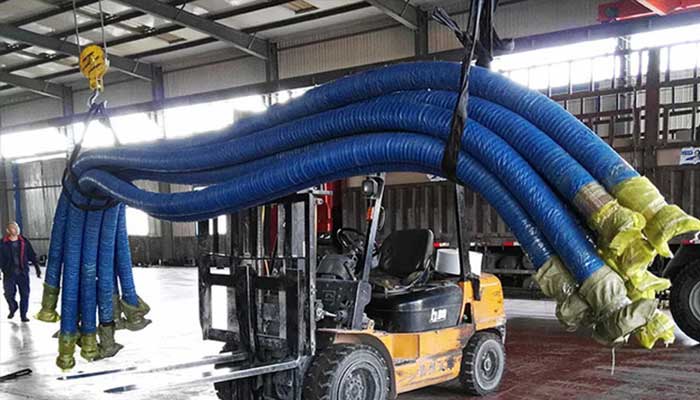
Custom overhead bridge crane for sale rubber pipe manufacturing industry
Why overhead cranes are so important for rubber industry ?
Overhead cranes are essential in the rubber industry due to their significant impact on productivity, safety, and efficiency in material handling processes. Here are some reasons why overhead cranes are crucial for the rubber industry:
- Efficient Material Handling Overhead cranes enable the movement of heavy and bulky raw materials, molds, and finished products with ease and speed. They help streamline material flow within the production facility, reducing downtime and optimizing production processes.
- Safety and Ergonomics Handling rubber materials manually can be physically demanding and potentially hazardous for workers. Overhead cranes provide a safer alternative, reducing the risk of accidents and injuries associated with heavy lifting and material transportation.
- Precise Positioning Overhead cranes offer precise and controlled movement, allowing accurate positioning of molds during the shaping and molding processes. This precision contributes to consistent product quality and reduces material waste.
- Increased Production Capacity By expediting material handling and reducing manual labor, overhead cranes can significantly increase production capacity and output in the rubber industry. This leads to faster turnaround times and improved overall efficiency.
- Optimized Workflow Overhead cranes facilitate the smooth movement of materials and products between different workstations, storage areas, and processing stages. They minimize congestion and bottlenecks in the production process, improving workflow efficiency.
- Handling Heavy Loads The rubber industry often deals with large and heavy rolls of raw materials and finished products. Overhead cranes are capable of handling such heavy loads, which may be impractical or unsafe for manual handling.
- Flexibility and Adaptability Overhead cranes can be customized to suit the specific needs of the rubber industry. They can be equipped with different lifting attachments and hoisting devices to handle various types of rubber materials and products.
- Cleanroom Compatibility In medical and certain specialized rubber manufacturing processes, cleanroomcompatible overhead cranes are used to maintain strict cleanliness standards in sensitive production environments.
- Vulcanization and Curing Support Overhead cranes assist in transferring rubber products to and from curing ovens or autoclaves during the vulcanization process. They ensure proper heat treatment and consistent product quality.
- Optimal Space Utilization Overhead cranes operate on elevated tracks, allowing them to utilize vertical space efficiently. This feature is particularly valuable in facilities with limited floor space.
Overall, overhead cranes play a critical role in enhancing the productivity, safety, and overall efficiency of material handling processes in the rubber industry. They contribute to cost savings, improved product quality, and a safer working environment for the industry's workforce.
Main types of overhead cranes used for rubber industry
The main types of overhead cranes used in the rubber industry can vary based on the specific production procedures and material handling requirements. Here are some common types of overhead cranes and their main functions for each rubber product manufacturing process:
- Bridge Cranes (EOT Cranes Electric Overhead Traveling Cranes) Bridge cranes are versatile and widely used in the rubber industry for general material handling, loading and unloading raw materials like rubber compounds, steel cords, and fabric sheets during tire manufacturing. They are also used for transferring finished products between workstations or storage areas.
- Gantry Cranes Gantry cranes are suitable for handling heavy rolls of rubber belts and hoses in the production process of belts and hoses. They are used for lifting and moving materials and products within the manufacturing facility.
- Jib Cranes Jib cranes are used for precise handling and assembly of smaller rubber seal and gasket components. They are ideal for workstationspecific tasks and smallerscale material handling in various rubber product manufacturing processes.
- Monorail Cranes Monorail cranes are used in continuous production lines for rubber mats and flooring, moving the products along a fixed path during the manufacturing process.
- Hoist Cranes Hoist cranes are utilized in various rubber product manufacturing processes for precise lifting and positioning of heavy molds, components, and finished products.
- Automated Cranes (Robotic Cranes) Automated cranes, such as robotic cranes, are used in some rubber product manufacturing processes that require precision and integration with other automated systems. They can handle tasks like precise placement and assembly of rubber components.
- Foundry Cranes Foundry cranes are designed to withstand high temperatures and harsh environments. They are used in rubber product manufacturing processes that involve casting, molding, and pouring molten rubber or other materials.
- Rubber Tyred Gantry (RTG) Cranes RTG cranes are used in rubber product manufacturing facilities that handle large volumes of materials. They are utilized for stacking and moving rubber sheets, blocks, and other raw materials in storage yards.
- Bridge Cranes with Special Hoisting Devices (e.g., Clamps, Hooks, Suction Cups) -Some rubber product manufacturing processes may require specialized hoisting devices to handle the products securely. These overhead cranes are equipped with specific tools like clamps, hooks, or suction cups to suit the unique material handling needs.
The main functions of overhead cranes in the rubber industry are to efficiently handle raw materials, molds, components, and finished products during the various manufacturing processes. They ensure safe and precise movement, enhance productivity, and contribute to a smooth and streamlined production workflow in the rubber industry.
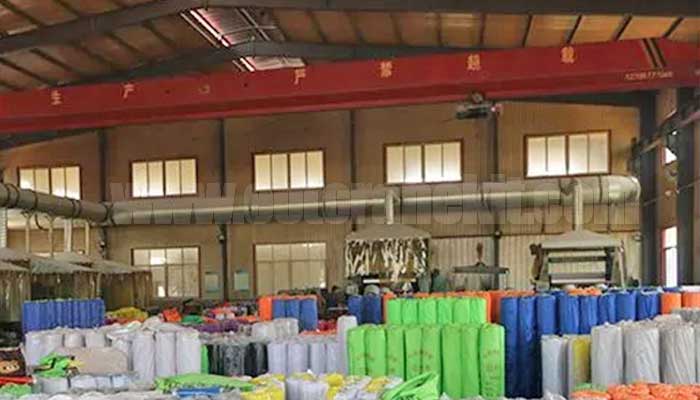
single girder overhead crane for rubber processing industry
Overhead crane used for each procedure of rubber manufacturing , handling and storage
The main production procedures of rubber and rubber products can vary depending on the specific type of rubber being used and the intended application of the final product. However, some common steps involved in the production of rubber and rubber based products are as follows:
Raw Material Preparation:
- Natural Rubber:For natural rubber, the process starts with tapping rubber trees to extract latex. The collected latex is then coagulated using chemicals or allowed to dry in molds to form rubber sheets or blocks.
- Synthetic Rubber:Synthetic rubber is derived from petroleumbased materials through a chemical polymerization process.
- Cranes Used:Bridge Cranes, Gantry Cranes
- Functions of Cranes: These cranes are used for handling and moving raw materials such as rubber compounds, steel cords, fabric sheets, and other ingredients to the processing areas. They ensure efficient and safe material handling during the initial stages of rubber production.
Mixing:
- The rubber material, whether natural or synthetic, is mixed with various additives, such as vulcanizing agents, accelerators, fillers, and stabilizers. These additives improve the rubber's properties, such as strength, elasticity, and resistance to heat and chemicals.
- Cranes Used: Bridge Cranes, Gantry Cranes, Jib Cranes
- Functions of Cranes: These cranes assist in handling various ingredients and additives needed for rubber compounding. They are used to lift and transport heavy bags of additives, fillers, and chemicals to the mixing stations.
Molding/Extrusion:
- Molding: The rubber mixture is shaped into the desired form using various molding techniques. This can involve compression molding, transfer molding, or injection molding, depending on the complexity of the product.
- Extrusion: For products with continuous shapes, like hoses and tubes, the rubber compound is forced through a die to create the desired crosssectional profile.
Vulcanization/Curing:
- Vulcanization is a critical step in the rubber production process. The molded or extruded rubber product is exposed to heat and pressure in a vulcanization process. This crosslinks the polymer chains in the rubber, enhancing its strength, elasticity, and durability. Sulfur is commonly used as a vulcanizing agent.
- Cranes Used: Bridge Cranes, Gantry Cranes
- Functions of Cranes: During vulcanization and curing processes, cranes are used to move rubber molds and products to and from curing ovens or autoclaves. They ensure precise positioning and safe handling of hot or cured rubber components.
Finishing:
- After vulcanization, the rubber product may undergo additional finishing processes, such as cutting, grinding, or surface treatment, to achieve the desired final appearance and dimensions.
Quality Control:
- Throughout the production process, quality control measures are taken to ensure that the rubber products meet specific standards and requirements. This involves inspecting the products for defects, dimensional accuracy, and performance characteristics.
Testing:
- Rubber products may undergo various tests to assess their properties, such as tensile strength, elongation, hardness, and resistance to heat, chemicals, and environmental factors.
Molding and Shaping
- Cranes Used: Bridge Cranes, Gantry Cranes, Jib Cranes
- Functions of Cranes: Cranes are used to lift and position molds for shaping rubber products. They assist in the molding process and ensure accurate placement of molds for consistent product quality.
Finishing and Inspection
- Cranes Used: Jib Cranes, Bridge Cranes
- Functions of Cranes: Jib cranes are often used in finishing areas for precise handling and inspection of smaller rubber components. Bridge cranes may also be used for transferring finished products to quality control and packaging areas.
Packaging and Distribution:
- Once the rubber products pass quality checks and tests, they are packaged and prepared for distribution to various industries and consumers.
- The production of rubber and rubber products involves a combination of traditional techniques and advanced manufacturing processes to create a wide range of goods, from simple rubber bands to complex automotive components and specialized industrial equipment.
Material Storage and Transportation
- Cranes Used: Rubber Tyred Gantry (RTG) Cranes, Bridge Cranes
- Functions of Cranes: RTG cranes are used in rubber product manufacturing facilities for stacking and moving rubber sheets, blocks, and other raw materials in storage yards. Bridge cranes can also assist in material transportation within the facility.
Automated Handling and Assembly
- Cranes Used: Automated Cranes (Robotic Cranes)
- Functions of Cranes: In advanced rubber manufacturing facilities, automated cranes, such as robotic cranes, may be used for tasks that require precision, repetitive movements, and integration with other automated systems. They facilitate efficient and precise handling and assembly of rubber components.
Foundry Processes (For Some Rubber Types)
- Cranes Used: Foundry Cranes
- Functions of Cranes: Foundry cranes are designed to withstand high temperatures and harsh environments. They are used in rubber product manufacturing processes that involve casting, molding, and pouring molten rubber or other materials.
Cranes play a crucial role in the rubber industry by ensuring smooth material handling, improving productivity, and maintaining a safe working environment throughout the manufacturing process. The specific type of crane used in each procedure depends on factors such as the size and weight of the materials being handled, the manufacturing facility's layout, and the precision required in the production process.
Typical overhead cranes for different rubber products handling
For the production and handling of the various rubber products mentioned, different types of overhead cranes may be used. The selection of the appropriate crane depends on the specific manufacturing process and the weight and size of the materials being handled. Here are some typical overhead cranes used for each type of rubber product:
- Tires Overhead Bridge Cranes: Used for handling raw materials like rubber compounds, steel cords, and fabric sheets during tire manufacturing.
- Belts and Hoses Gantry Cranes: Useful for moving heavy rolls of rubber belts and hoses within the production facility.
- Seals and Gaskets Jib Cranes: Suitable for precise handling and assembly of smaller rubber seal and gasket components.
- Rubber Mats and Flooring Monorail Cranes: Ideal for continuous production lines where rubber mats and flooring are moved along a fixed path.
- Rubber Footwear Hoist Cranes: Used in the production process for precise lifting and positioning of rubber footwear components.
- Medical and Surgical Products Cleanroom Cranes: Required for the handling of medical products in sterile environments.
- Rubber Sealing Rings and Orings Automated Cranes (Robotic Cranes): Suitable for precise placement and assembly of rubber sealing components.
- Vibration Isolators and Dampers Bridge Cranes: Used in the manufacturing process for handling large rubber dampers and isolators.
- Rubber Bushings and Mounts Gantry Cranes: Useful for handling heavy rubber bushings and mounts during production.
- Rubber Conveyor Rollers and Wheels Bridge Cranes: Used for handling and assembling large rubber conveyor rollers and wheels.
- Rubber Diaphragms Jib Cranes: Suitable for precise handling and assembly of rubber diaphragm components.
- Rubber Insulation and Weather Stripping Monorail Cranes: Ideal for handling long rubber strips used for insulation and weather stripping.
- Rubber Expansion Joints Bridge Cranes: Used for handling and assembling large rubber expansion joints.
- Rubber Automotive Components Gantry Cranes: Used for handling heavy rubber automotive parts in the manufacturing process.
- Rubber Adhesives and Sealants Automated Cranes (Robotic Cranes): Suitable for precise application of rubber adhesives and sealants during bonding processes.
It's important to note that each rubber product's manufacturing process and facility setup may differ, and therefore, the choice of overhead crane may vary accordingly. Safety, efficiency, and ergonomics are key factors considered while selecting the appropriate overhead crane for handling rubber products in a manufacturing setting.
Overhead cranes for rubber application sectors
Rubber products have a wide range of applications in various industries due to their unique properties, including elasticity, flexibility, and resistance to abrasion and chemicals. Some of the main applications of rubber products include:
- Automotive Industry Rubber is extensively used in the automotive sector for manufacturing tires, belts, hoses, seals, gaskets, engine mounts, suspension bushings, and various other components.
- Construction and Infrastructure Rubber is employed in the construction industry for manufacturing rubber roofing materials, insulation, gaskets, seals, and rubberized asphalt for road surfaces.
- Transportation and Aerospace Rubber products find applications in transportation, including railways and aerospace, for antivibration mounts, gaskets, seals, and other components.
- Industrial Machinery and EquipmentRubber is used for making conveyor belts, antivibration pads, seals, grommets, diaphragms, and various other parts in industrial machinery and equipment.
- Medical and HealthcareRubber products are utilized in medical and healthcare settings for gloves, tubing, catheters, medical seals, and other medical devices due to their hypoallergenic and flexible properties.
- Electrical and Electronics Rubber is used for insulating electrical wires and cables, manufacturing electronic components like keypads, gaskets, and Orings for electronic devices.
- Sporting Goods Rubber is widely used in sporting goods like balls, grips, mats, and shockabsorbing materials for sports equipment.
- Consumer GoodsRubber products are present in various consumer goods, including footwear (shoes, boots, flipflops), rubber bands, erasers, and household items like rubber gloves and door stoppers.
- Marine and Offshore Industry Rubber is utilized in marine applications for boat fenders, marine hoses, seals, and offshore oil and gas equipment for their resistance to saltwater and harsh environmental conditions.
- AgricultureRubber products are used in agriculture for making tractor tires, conveyor belts, hoses, and seals for irrigation systems.
- Mining Rubber is employed in mining operations for conveyor belts, wearresistant linings, and various components for mining equipment.
- Oil and Gas Industry Rubber products find applications in the oil and gas industry for seals, gaskets, and hoses used in drilling and processing operations.
These are just a few examples of the many applications of rubber products across different industries. The versatility of rubber makes it an essential material in various sectors, contributing to modern life and industrial processes.
Regulations and Requirements for overhead cranes for rubber industry
The use of overhead cranes in the rubber industry is subject to various industry regulations and safety standards to ensure the well being of workers, equipment integrity, and compliance with legal requirements. Some key regulations and standards that pertain to overhead cranes in rubber manufacturing include:
- OSHA (Occupational Safety and Health Administration) Standards OSHA sets safety standards for the operation, maintenance, and inspection of overhead cranes. Compliance with OSHA regulations is essential to create a safe working environment and prevent accidents.
- CMAA (Crane Manufacturers Association of America) Standards CMAA provides guidelines and standards for the design, construction, and operation of overhead cranes. Manufacturers must adhere to CMAA standards to ensure the crane's reliability and performance.
- ASME B30.2 (American Society of Mechanical Engineers) Standards ASME B30.2 specifically addresses overhead and gantry cranes, providing guidelines for safe operation, inspection, and maintenance.
- ANSI (American National Standards Institute) Standards ANSI publishes standards that cover various aspects of crane design, operation, and safety.
To ensure compliance with these regulations, manufacturers of overhead cranes should design their products to meet or exceed the specified safety standards. Additionally, they must provide comprehensive documentation, user manuals, and training materials to ensure that crane operators and maintenance personnel are aware of proper operating procedures and safety protocols.
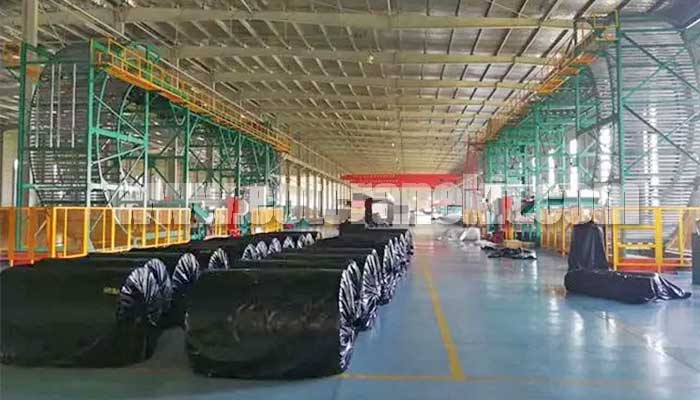
double girder overhead crane for rubber handling
Requirements for overhead cranes
Overhead cranes used in the rubber industry may have specific requirements to ensure efficient and safe material handling processes. Some of the special requirements for overhead cranes used in the rubber industry include:
- Corrosion Resistance The rubber industry often involves exposure to various chemicals and fluids. Overhead cranes must have corrosionresistant components and coatings to withstand potentially corrosive environments.
- Cleanroom Compatibility In medical and certain specialized rubber manufacturing processes, cleanroomcompatible overhead cranes may be necessary to maintain strict cleanliness standards.
- Heat Resistance Cranes used in rubber manufacturing processes involving vulcanization or hightemperature conditions must be designed to withstand elevated temperatures without compromising performance.
- Load Capacity Overhead cranes in the rubber industry should have sufficient load capacity to handle heavy rolls of raw materials, molds, and finished products commonly encountered in the production process.
- Precision Control Some rubber products require precise handling and positioning during the manufacturing process. Overhead cranes with accurate and smooth control systems are necessary for such applications.
- Gentle Material Handling Rubber materials can be sensitive to damage and deformation. The crane's lifting and movement mechanisms should provide gentle handling to prevent any harm to the rubber products.
- Safety Features Safety is paramount in any industrial setting. Overhead cranes used in the rubber industry should have safety features such as overload protection, emergency stop buttons, anticollision systems, and limit switches to ensure safe operations.
- Flexibility and Maneuverability Overhead cranes should be designed to maneuver effectively in production spaces with limited headroom and obstacles, allowing them to access various workstations and storage areas.
- Suitable Hoisting Devices Depending on the specific rubber products being handled, the crane may require specialized hoisting devices, such as clamps, hooks, or suction cups, to ensure secure lifting and positioning.
- Easy Maintenance Regular maintenance is essential to keep overhead cranes in optimal working condition. Cranes should be designed with ease of maintenance in mind to minimize downtime and ensure consistent performance.
- Compliance with Standards Overhead cranes used in the rubber industry must adhere to relevant safety and quality standards, ensuring their reliability and suitability for the intended applications.
- Environmental Considerations In some cases, rubber production may generate dust or emissions. Overhead cranes should be designed to minimize any potential environmental impact and be equipped with appropriate air filtration systems, if necessary.
- By meeting these special requirements, overhead cranes can effectively support the rubber industry's material handling needs, enhance productivity, and maintain a safe working environment throughout the manufacturing process.
What are the cost of overhead crane used for rubber industry ?
The cost of an overhead crane used in the rubber industry can vary widely based on several factors. The cost is influenced by the crane's capacity, span, lifting height, speed, features, and the specific requirements of the rubber manufacturing facility. Additionally, installation, shipping, and any optional accessories or customizations can also impact the overall cost. As of my last update in September 202, I can provide a general price range for different types of overhead cranes typically used in the rubber industry:
- Bridge Cranes (EOT Cranes) The cost of a bridge crane with a capacity of around 5 to 10 tons, a span of 20 to 30 meters, and a lifting height of 6 to 12 meters can range from $20,000 to $100,000 or more, depending on the specific features and customization required.
- Gantry Cranes Gantry cranes are often more expensive than bridge cranes due to their outdoor capability and larger sizes. The cost of a gantry crane with a capacity of 10 to 50 tons, a span of 20 to 40 meters, and a lifting height of 6 to 12 meters can range from $50,000 to $300,000 or more.
- Jib Cranes Jib cranes are generally more affordable compared to bridge and gantry cranes. The cost of a jib crane with a capacity of to 5 tons and a reach of 3 to 6 meters can range from $5,000 to $20,000.
- Monorail Cranes Monorail cranes are typically used in continuous production lines. The cost of a monorail crane with a capacity of to 5 tons and a span of 20 to 50 meters can range from $15,000 to $50,000 or more.
- Rubber Tyred Gantry (RTG) Cranes RTG cranes are larger and more expensive due to their heavyduty applications. The cost of an RTG crane with a capacity of 20 to 50 tons, a span of 20 to 40 meters, and a lifting height of 10 to 20 meters can range from $200,000 to $,000,000 or more.
It is essential to note that these cost ranges are approximate and can vary significantly based on the crane manufacturer, geographical location, and additional features required for specific rubber manufacturing processes. The best approach to determine the exact cost of an overhead crane for a rubber industry application is to request quotes from reputable crane manufacturers or suppliers. They can provide detailed quotations based on the specific requirements of your facility and application. Additionally, consider the longterm benefits and ROI of the overhead crane when evaluating the overall cost.
Cost Analysis and ROI
Implementing overhead cranes in rubber manufacturing facilities involves an initial investment, but the benefits often outweigh the costs in the long run. Conducting a cost analysis and calculating the return on investment (ROI) is essential to make informed decisions. Here are some factors to consider in the cost analysis:
- Initial Investment Include the costs of purchasing the overhead crane, installation, commissioning, and any necessary modifications to the facility.
- Operating Costs Factor in energy consumption, maintenance, and repair costs over the crane's expected lifespan.
- Labor Savings Evaluate the reduction in manual labor required for material handling tasks. Overhead cranes can handle heavy loads efficiently, reducing the need for manual lifting and transport, and potentially leading to labor cost savings.
- Productivity Gains Assess the impact of overhead cranes on production efficiency. Faster and safer material handling can lead to increased throughput and reduced production time, positively affecting overall productivity.
- Safety Improvements Consider the potential cost savings from accident prevention and reduced downtime resulting from improved safety measures provided by overhead cranes.
- ROI Calculation Calculate the ROI by comparing the total benefits (labor savings, productivity gains, safety improvements, etc.) over the expected lifespan of the crane to the initial investment and ongoing operating costs.
By conducting a thorough cost analysis and ROI calculation, rubber manufacturers can determine whether the implementation of overhead cranes is financially viable and how quickly they can recoup their investment through increased productivity and reduced operational costs. This analysis also helps in selecting the most suitable crane model and features to maximize the benefits while staying within budget constraints.
Custom Overhead Crane for Your Rubber Manufacturing Facility
We specialize in designing tailored solutions for rubber product handling, catering to your specific requirements! Whether you need to lift and move heavy rubber materials or streamline production processes, our custom overhead cranes are built to deliver optimal efficiency and safety.
Why Choose Us?
- Expertise in Rubber Handling: With years of experience in the rubber industry, we understand the unique challenges you face and can design cranes that perfectly suit your needs.
- Safety First: Our cranes come equipped with advanced safety features to ensure a secure working environment for your team.
- Personalized Design: We collaborate closely with you to craft a custom overhead crane that precisely matches your rubber manufacturing workflow.
- Quality and Reliability: Our cranes are built to the highest standards, using premium materials to ensure durability and longlasting performance.
Contact us now to discuss your rubber handling requirements and get a free consultation on how our custom overhead cranes can transform your operations. Let's elevate your rubber manufacturing to new heights together!
